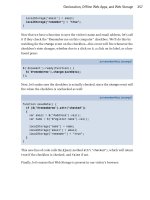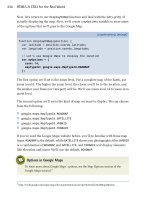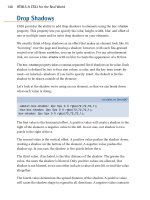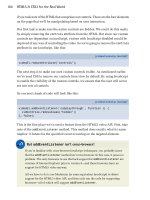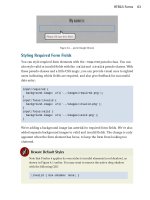Big data little data no data scholarship in the networked world MIT press
Bạn đang xem bản rút gọn của tài liệu. Xem và tải ngay bản đầy đủ của tài liệu tại đây (5.32 MB, 411 trang )
Big Data, Little Data, No Data
Big Data, Little Data, No Data
Scholarship in the Networked World
Christine L. Borgman
The MIT Press
Cambridge, Massachusetts
London, England
© 2015 Christine L. Borgman
All rights reserved. No part of this book may be reproduced in any form by
any electronic or mechanical means (including photocopying, recording, or
information storage and retrieval) without permission in writing from the
publisher.
MIT Press books may be purchased at special quantity discounts for business or
sales promotional use. For information, please email
edu.
This book was set in Stone Sans and Stone Serif by the MIT Press. Printed and
bound in the United States of America.
Library of Congress Cataloging-in-Publication Data
Borgman, Christine L., 1951–
Big data, little data, no data : scholarship in the networked world / Christine L.
Borgman.
pages cm
Includes bibliographical references and index.
ISBN 978-0-262-02856-1 (hardcover : alk. paper)
1. Communication in learning and scholarship—Technological innovations.
2. Research—Methodology. 3. Research—Data processing. 4. Information
technology. 5. Information storage and retrieval systems. 6. Cyberinfrastructure.
I. Title.
AZ195.B66 2015
004—dc23
2014017233.
ISBN: 978–0-262–02856–1
10 9 8 7 6 5 4 3 2 1
For Betty Champoux Borgman, 1926–2012,
and Ann O’Brien, 1951–2014
Contents
Detailed Contents ix
Preface xvii
Acknowledgments xxi
Part I: Data and Scholarship 1
1
2
3
4
Provocations 3
What are Data? 17
Data Scholarship 31
Data Diversity 55
Part II: Case Studies in Data Scholarship 81
5
6
7
Data Scholarship in the Sciences 83
Data Scholarship in the Social Sciences 125
Data Scholarship in the Humanities 161
Part III: Data Policy and Practice 203
8 Releasing, Sharing, and Reusing Data 205
9 Credit, Attribution, and Discovery 241
10 What to Keep and Why 271
References 289
Index 361
Detailed Table of Contents
Preface xvii
Acknowledgments xxi
Part I: Data and Scholarship 1
1 Provocations 3
Introduction 3
Big Data, Little Data 4
Bigness 5
Openness 7
The Long Tail 8
No Data 10
Data Are Not Available 11
Data Are Not Released 11
Data Are Not Usable 13
Provocations 13
Conclusion 15
2
What Are Data? 17
Introduction 17
Definitions and Terminology 18
Definitions by Example 19
Operational Definitions 20
Categorical Definitions 21
Degrees of Processing 21
Origin and Preservation Value 23
Collections 25
Conceptual Distinctions 26
x
Detailed Table of Contents
Sciences and Social Sciences 26
Humanities 27
Conclusion 28
3
Data Scholarship 31
Introduction 31
Knowledge Infrastructures 32
The Social and the Technical 35
Communities and Collaboration 36
Knowledge and Representation 37
Theory, Practice, and Policy 38
Open Scholarship 39
Open Access to Research Findings 39
Open Access to Data 42
Open Technologies 45
Converging Communication 47
Data Metaphors 47
Units of Data 50
Documents of Record 51
Conclusion 52
4
Data Diversity 55
Introduction 55
Disciplines and Data 56
Size Matters 58
Project Goals 58
Data Collection 60
Data Analysis 61
When Are Data? 62
Distance Matters 64
Sources and Resources 64
Metadata 65
Definitions and Discovery 66
Communities and Standards 68
Provenance 70
External Influences 71
Economics and Values 71
Property Rights 75
Ethics 77
Conclusion 79
Detailed Table of Contents
Part II: Case Studies in Data Scholarship 81
5
Data Scholarship in the Sciences 83
Introduction 83
Research Methods and Data Practices 83
Science Cases 84
Astronomy 85
Size Matters 86
Big Science, Little Science 86
Big Data, Long Tail 87
When Are Data? 90
Sources and Resources 91
Telescopes 91
Electromagnetic Spectrum 92
Celestial Objects 93
Astronomy Data Products 93
Knowledge Infrastructures 94
Metadata 94
Coordinate Systems 95
Celestial Objects 96
Data Archiving 97
Publications 98
Provenance 99
External Influences 100
Economics and Value 100
Property Rights 100
Ethics 101
Conducting Research in Astronomy 102
The COMPLETE Survey 102
Research Questions 103
Collecting Data 103
Analyzing Data 104
Publishing Findings 104
Curating, Sharing, and Reusing Data 105
Sensor-Networked Science and Technology 106
Size Matters 106
When Are Data? 108
Sources and Resources 109
Embedded Sensor Networks 109
Physical Samples 111
Software, Code, Scripts, and Models 111
Background Data 111
xi
xii
Detailed Table of Contents
Knowledge Infrastructures 112
Metadata 112
Provenance 113
External Influences 113
Economics and Value 113
Property Rights 114
Ethics 115
Conducting Research with Embedded Sensor Networks 116
Research Questions 117
Collecting Data 117
Analyzing Data 119
Publishing Findings 119
Curating, Sharing, and Reusing Data 120
Conclusion 121
6
Data Scholarship in the Social Sciences 125
Introduction 125
Research Methods and Data Practices 126
Social Sciences Cases 127
Internet Surveys and Social Media Studies 128
Size Matters 128
When Are Data? 129
Sources and Resources 129
Knowledge Infrastructures 131
Metadata 132
Provenance 133
External Influences 135
Economics and Value 135
Property Rights 136
Ethics 136
Conducting Internet Surveys and Social Media Research 137
Research Questions 138
Collecting Data 139
Analyzing Data 140
Publishing Findings 141
Curating, Sharing, and Reusing Data 142
Sociotechnical Studies 143
Size Matters 144
When Are Data? 144
Sources and Resources 145
Field Observations and Ethnography 145
Interviews 146
Detailed Table of Contents
Records and Documents 146
Building and Evaluating Technologies 147
Knowledge Infrastructures 147
Metadata 148
Provenance 148
External Influences 149
Economics and Value 149
Property Rights 149
Ethics 150
Conducting Sociotechnical Research in CENS 150
Research Questions 151
Collecting Data 152
Analyzing Data 154
Publishing Findings 155
Curating, Sharing, and Reusing Data 156
Conclusion 157
7
Data Scholarship in the Humanities 161
Introduction 161
Research Methods and Data Practices 162
Humanities Cases 164
Classical Art and Archaeology 164
Size Matters 165
When Are Data? 166
Sources and Resources 166
Physical versus Digital Objects 167
Digital versus Digitized 167
Surrogates versus Full Content 167
Static Images versus Searchable Representations 168
Searchable Strings versus Enhanced Content 169
Knowledge Infrastructures 170
Metadata 171
Provenance 172
Collections 173
External Factors 176
Economics and Value 176
Property Rights 178
Ethics 178
Conducting Research in Classical Art and Archaeology 179
Research Questions 180
Collecting Data 181
Analyzing Data 182
xiii
xiv
Detailed Table of Contents
Publishing Findings 184
Curating, Sharing, and Reusing Data 184
Buddhist Studies 186
Size Matters 187
When Are Data? 187
Sources and Resources 188
Primary versus Secondary Sources 188
Static Images versus Enhanced Content 189
Knowledge Infrastructures 189
Metadata 190
Provenance 191
Collections 191
External Factors 192
Economics and Value 192
Property Rights 193
Ethics 193
Conducting Research in Buddhist Studies 194
Research Questions 195
Collecting Data 196
Analyzing Data 196
Publishing Findings 197
Curating, Sharing, and Reusing Data 199
Conclusion 200
Part III: Data Policy and Practice 203
8
Sharing, Releasing, and Reusing Data 205
Introduction 205
Supply and Demand for Research Data 207
The Supply of Research Data 208
To Reproduce Research 209
Defining Reproducibility 209
Determining What to Reproduce 209
Detecting Fraud 210
Resolving Disputes 211
To Make Public Assets Available to the Public 211
To Leverage Investments in Research 212
To Advance Research and Innovation 212
The Demand for Research Data 213
Scholarly Motivations 214
Publications and Data 215
Detailed Table of Contents
Communicating Research 215
Publishing Research 216
Data as Assets and Liabilities 217
Releasing Data 218
Representation and Mobility 219
Provenance 220
Acquiring Data to Reuse 222
Background and Foreground Uses 222
Interpretation and Trust 223
Knowledge Infrastructures 224
Repositories, Collections, and Archives 225
Private Practice 227
Human Infrastructure 228
Intractable Problems 229
Disciplinary Knowledge Infrastructures 229
Sciences 230
Astronomy 230
Sensor Networked Science and Technology 231
Genomics 233
Social Sciences 235
Internet Research 235
Sociotechnical Research 235
Humanities 236
Classical Art and Archaeology 236
Buddhist Studies 237
Conclusion 237
9
Credit, Attribution, and Discovery of Data 241
Introduction 241
Principles and Problems 243
Theory and Practice 245
Substance and Style: How to Cite 245
Theories of Citation Behavior: What, When, and Why to Cite Objects 248
Meaning of Links 248
Selecting References 249
Theorizing and Modeling Citation Behavior 250
Citing Data 251
Clear or Contested: Who Is Credited and Attributed? 252
Naming the Cited Author 252
Negotiating Authorship Credit 253
Responsibility 255
Credit for Data 256
xv
xvi
Detailed Table of Contents
Name or Number: Questions of Identity 258
Identifying People and Organizations 258
Identity and Discovery 260
Identifying Objects 261
Theory Meets Technology: Citations as Actions 264
Risks and Rewards: Citations as Currency 266
Conclusion 268
10 What to Keep and Why 271
Introduction 271
Provocations Revisited 273
Rights, Responsibilities, Roles, and Risks 273
Data Sharing 275
Publications and Data 278
Data Access 281
Stakeholders and Skills 283
Knowledge Infrastructures Past, Present, and Future 285
Conclusion 287
References 289
Index 361
Preface
Big data begets big attention these days, but little data are equally essential
to scholarly inquiry. As the absolute volume of data increases, the ability to
inspect individual observations decreases. The observer must step ever further away from the phenomena of interest. New tools and new perspectives
are required. However, big data is not necessarily better data. The farther
the observer is from the point of origin, the more difficult it can be to determine what those observations mean—how they were collected; how they
were handled, reduced, and transformed; and with what assumptions and
what purposes in mind. Scholars often prefer smaller amounts of data that
they can inspect closely. When data are undiscovered or undiscoverable,
scholars may have no data.
Research data are much more—and less—than commodities to be
exploited. Data management plans, data release requirements, and other
well-intentioned policies of funding agencies, journals, and research institutions rarely accommodate the diversity of data or practices across domains.
Few policies attempt to define data other than by listing examples of what
they might be. Even fewer policies reflect the competing incentives and
motivations of the many stakeholders involved in scholarship. Data can
be many things to many people, all at the same time. They can be assets
to be controlled, accumulated, bartered, combined, mined, and perhaps to
be released. They can be liabilities to be managed, protected, or destroyed.
They can be sensitive or confidential, carrying high risks if released. Their
value may be immediately apparent or not realized until a time much later.
Some are worth the investment to curate indefinitely, but many have only
transient value. Within hours or months, advances in technology and
research fronts have erased the value in some kinds of observations.
A starting point to understand the roles of data in scholarship is
to acknowledge that data rarely are things at all. They are not natural
objects with an essence of their own. Rather, data are representations of
xviii Preface
observations, objects, or other entities used as evidence of phenomena
for the purposes of research or scholarship. Those representations vary by
scholar, circumstance, and over time. Across the sciences, social sciences,
and the humanities, scholars create, use, analyze, and interpret data, often
without agreeing on what those data are. Conceptualizing something as
data is itself a scholarly act. Scholarship is about evidence, interpretation,
and argument. Data are a means to an end, which is usually the journal
article, book, conference paper, or other product worthy of scholarly recognition. Rarely is research done with data reuse in mind.
Galileo sketched in his notebook. Nineteenth-century astronomers took
images on glass plates. Today’s astronomers use digital devices to capture
photons. Images of the night sky taken with consumer-grade cameras can
be reconciled to those taken by space missions because astronomers have
agreed on representations for data description and mapping. Astronomy
has invested heavily in standards, tools, and archives so that observations
collected over the course of several centuries can be aggregated. However,
the knowledge infrastructure of astronomy is far from complete and far
from fully automated. Information professionals play key roles in organizing and coordinating access to data, astronomical and otherwise.
Relationships between publications and data are manifold, which is
why research data is fruitfully examined within the framework of scholarly communication. The making of data may be deliberate and long term,
accumulating a trove of resources whose value increases over time. It may
be ad hoc and serendipitous, grabbing whatever indicators of phenomena
are available at the time of occurrence. No matter how well defined the
research protocol, whether for astronomy, sociology, or ethnography, the
collection of data may be stochastic, with findings in each stage influencing choices of data for the next. Part of becoming a scholar in any field is
learning how to evaluate data, make decisions about reliability and validity,
and adapt to conditions of the laboratory, field site, or archive. Publications that report findings set them in the context of the domain, grounding
them in the expertise of the audience. Information necessary to understand
the argument, methods, and conclusions are presented. Details necessary
to replicate the study are often omitted because the audience is assumed
to be familiar with the methods of the field. Replication and reproducibility, although a common argument for releasing data, are relevant only
in selected fields and difficult to accomplish even in those. Determining
which scholarly products are worth preserving is the harder problem.
Policies for data management, release, and sharing obscure the complex
roles of data in scholarship and largely ignore the diversity of practices
Preface xix
within and between domains. Concepts of data vary widely across the sciences, social sciences, and humanities, and within each area. In most fields,
data management is learned rather than taught, leading to ad hoc solutions. Researchers often have great difficulty reusing their own data. Making those data useful to unknown others, for unanticipated purposes, is
even harder. Data sharing is the norm in only a few fields because it is very
hard to do, incentives are minimal, and extensive investments in knowledge infrastructures are required.
This book is intended for the broad audience of stakeholders in research
data, including scholars, researchers, university leaders, funding agencies, publishers, libraries, data archives, and policy makers. The first section frames data and scholarship in four chapters, provoking a discussion
about concepts of data, scholarship, knowledge infrastructures, and the
diversity of research practices. The second section consists of three chapters
exploring data scholarship in the sciences, social sciences, and humanities.
These case studies are parallel in structure, providing comparisons across
domains. The concluding section spans data policy and practice in three
chapters, exploring why data scholarship presents so many difficult problems. These include releasing, sharing, and reusing data; credit, attribution,
and discovery; and what to keep and why.
Scholarship and data have long and deeply intertwined histories. Neither are new concepts. What is new are efforts to extract data from scholarly processes and to exploit them for other purposes. Costs, benefits, risks,
and rewards associated with the use of research data are being redistributed
among competing stakeholders. The goal of this book is to provoke a much
fuller, and more fully informed, discussion among those parties. At stake is
the future of scholarship.
Christine L. Borgman
Los Angeles, California
May 2014
Acknowledgments
It takes a village to write a sole-authored book, especially one that spans
as many topics and disciplines as does this one. My writing draws upon
the work of a large and widely distributed village of colleagues—an “invisible college” in the language of scholarly communication. Scholars care
passionately about their data and have given generously of their time in
countless discussions, participation in seminars and workshops, and reading many drafts of chapters.
The genesis of this book project goes back too many years to list all who
have influenced my thinking, thus these acknowledgments can thank, at
best, those who have touched the words in this volume in some way. Many
more are identified in the extensive bibliography. No doubt I have failed to
mention more than a few of you with whom I have had memorable conversations about the topics therein.
My research on scholarly data practices dates to the latter 1990s, building
on prior work on digital libraries, information-seeking behavior, humancomputer interaction, information retrieval, bibliometrics, and scholarly
communication. The data practices research has been conducted with a
fabulous array of partners whose generative contributions to my thinking incorporate too much tacit knowledge to be made explicit here. Our
joint work is cited throughout. Many of the faculty collaborators, students,
and postdoctoral fellows participated in multiple projects; thus, they are
combined into one alphabetical list. Research projects on scholarly data
practices include the Alexandria Digital Earth Prototype Project (ADEPT);
Center for Embedded Networked Sensing (CENS); Cyberlearning Task
Force; Monitoring, Modeling, and Memory; Data Conservancy; Knowledge
Infrastructures; and Long-Tail Research.
Faculty collaborators on these projects include Daniel Atkins, Geoffrey
Bowker, Sayeed Choudhury, Paul Davis, Tim DiLauro, George Djorgovski,
Paul Edwards, Noel Enyedy, Deborah Estrin, Thomas Finholt, Ian Foster,
xxii Acknowledgments
James Frew, Jonathan Furner, Anne Gilliland, Michael Goodchild, Alyssa
Goodman, Mark Hansen, Thomas Harmon, Bryan Heidorn, William
Howe, Steven Jackson, Carl Kesselman, Carl Lagoze, Gregory Leazer, Mary
Marlino, Richard Mayer, Carole Palmer, Roy Pea, Gregory Pottie, Allen
Renear, David Ribes, William Sandoval, Terence Smith, Susan Leigh Star,
Alex Szalay, Charles Taylor, and Sharon Traweek. Students, postdoctoral fellows, and research staff collaborators on these projects include Rebekah
Cummings, Peter Darch, David Fearon, Rich Gazan, Milena Golshan, Eric
Graham, David Gwynn, Greg Janee, Elaine Levia, Rachel Mandell, Matthew
Mayernik, Stasa Milojevic, Alberto Pepe, Elizabeth Rolando, Ashley Sands,
Katie Shilton, Jillian Wallis, and Laura Wynholds.
Most of this book was developed and written during my 2012–2013 sabbatical year at the University of Oxford. My Oxford colleagues were fountains of knowledge and new ideas, gamely responding to my queries of
“what are your data?” Balliol College generously hosted me as the Oliver
Smithies Visiting Fellow and Lecturer, and I concurrently held visiting
scholar posts at the Oxford Internet Institute and the Oxford eResearch
Centre. Conversations at high table and low led to insights that pervade
my thinking about all things data—Buddhism, cosmology, Dante, genomics, chirality, nanotechnology, education, economics, classics, philosophy,
mathematics, medicine, languages and literature, computation, and much
more. The Oxford college system gathers people together around a table
who otherwise might never meet, much less engage in boundary-spanning
inquiry. I am forever grateful to my hosts, Sir Drummond Bone, Master
of Balliol, and Nicola Trott, Senior Tutor; William Dutton of the Oxford
Internet Institute; David de Roure, Oxford eResearch Centre; and Sarah
Thomas, Bodley’s Librarian. My inspiring constant companions at Oxford
included Kofi Agawu, Martin Burton, George and Carmella Edwards,
Panagis Filippakopoulos, Marina Jirotka, Will Jones, Elena Lombardi, Eric
Meyer, Concepcion Naval, Peter and Shirley Northover, Ralph Schroeder,
Anne Trefethen, and Stefano Zacchetti.
Others at Oxford who enlightened my thinking, perhaps more than
they know, include William Barford, Grant Blank, Dame Lynne Brindley,
Roger Cashmore, Sir Iain Chalmers, Carol Clark, Douglas Dupree, Timothy
Endicott, David Erdos, Bertrand Faucheux, James Forder, Brian Foster, JohnPaul Ghobrial, Sir Anthony Graham, Leslie Green, Daniel Grimley, Keith
Hannabus, Christopher Hinchcliffe, Wolfram Horstmann, Sunghee Kim,
Donna Kurtz, Will Lanier, Chris Lintott, Paul Luff, Bryan Magee, Helen
Margetts, Philip Marshall, Ashley Nord, Dominic O’Brien, Dermot O’Hare,
Richard Ovenden, Denis Noble, Seamus Perry, Andrew Pontzen, Rachel
Acknowledgments xxiii
Quarrell, David Robey, Anna Sander, Brooke Simmons, Rob Simpson, JinChong Tan, Linnet Taylor, Rosalind Thomas, Nick Trefethen, David Vines,
Lisa Walker, David Wallace, Jamie Warner, Frederick Wilmot-Smith, and
Timothy Wilson.
Very special acknowledgments are due to my colleagues who contributed substantially to the case studies in chapters 5, 6, and 7. The astronomy
case in chapter 5 relies heavily on the contributions of Alyssa Goodman
of the Harvard-Smithsonian Center for Astrophysics and her collaborators, including Alberto Accomazzi, Merce Crosas, Chris Erdmann, Michael
Kurtz, Gus Muench, and Alberto Pepe. It also draws on the research of the
Knowledge Infrastructures research team at UCLA. The case benefited from
multiple readings of drafts by professor Goodman and reviews by other
astronomers or historians of astronomy, including Alberto Accomazzi,
Chris Lintott, Michael Kurtz, Patrick McCray, and Brooke Simmons. Astronomers George Djorgovski, Phil Marshall, Andrew Pontzen, and Alex Szalay also helped clarify scientific issues. The sensor-networked science and
technology case in chapter 5 draws on prior published work about CENS.
Drafts were reviewed by collaborators and by CENS science and technology researchers, including David Caron, Eric Graham, Thomas Harmon,
Matthew Mayernik, and Jillian Wallis. The first social sciences case in chapter 6, on Internet research, is based on interviews with Oxford Internet
Institute researchers Grant Blank, Corinna di Gennaro, William Dutton,
Eric Meyer, and Ralph Schroeder, all of whom kindly reviewed drafts of the
chapter. The second case, on sociotechnical studies, is based on prior published work with collaborators, as cited, and was reviewed by collaborators
Matthew Mayernik and Jillian Wallis. The humanities case studies in chapter 7 were developed for this book. The CLAROS case is based on interviews
and materials from Donna Kurtz of the University of Oxford, with further
contributions from David Robey and David Shotton. The analysis of the
Pisa Griffin draws on interviews and materials from Peter Northover, also of
Oxford, and additional sources from Anna Contadini of SOAS, London. The
closing case, on Buddhist scholarship, owes everything to the patient tutorial of Stefano Zacchetti, Yehan Numata Professor of Buddhist Studies at
Oxford, who brought me into his sanctum of enlightenment. Humanities
scholars were generous in reviewing chapter 7, including Anna Contadini,
Johanna Drucker, Donna Kurtz, Peter Northover, Todd Presner, Joyce Ray,
and David Robey.
Many others shared their deep expertise on specialized topics. On biomedical matters, these included Jonathan Bard, Martin Burton, Iain
Chalmers, Panagis Filippakopoulos, and Arthur Thomas. Dr. Filippakopoulos
xxiv Acknowledgments
read drafts of several chapters. On Internet technologies and citation mechanisms, these included Geoffrey Bilder, Blaise Cronin, David de Roure, Peter
Fox, Carole Goble, Peter Ingwersen, John Klensin, Carl Lagoze, Salvatore
Mele, Ed Pentz, Herbert van de Sompel, and Yorick Wilks. Chapter 9 was
improved by the comments of Blaise Cronin, Kathleen Fitzpatrick, and John
Klensin. Paul Edwards and Marilyn Raphael were my consultants on climate
modeling. Sections on intellectual property and open access benefited from
discussions with David Erdos, Leslie Green, Peter Hirtle, Peter Murray-Rust,
Pamela Samuelson, Victoria Stodden, and John Wilbanks. Christopher Kelty
helped to clarify my understanding of common-pool resources, building on
other discussions of economics with Paul David, James Forder, and David
Vines. Ideas about knowledge infrastructures were shaped by long-running
discussions with my collaborators Geoffrey Bowker, Paul Edwards, Thomas
Finholt, Steven Jackson, Cory Knobel, and David Ribes. Similarly, ideas about
data policy were shaped by membership on the Board on Research Data and
Information, on CODATA, on the Electronic Privacy Information Center,
and by the insights of Francine Berman, Clifford Lynch, Paul Uhlir, and Marc
Rotenberg. On issues of libraries and archives, I consulted Lynne Brindley,
Johanna Drucker, Anne Gilliland, Margaret Hedstrom, Ann O’Brien, Susan
Parker, Gary Strong, and Sarah Thomas. Jonathan Furner clarified philosophical concepts, building upon what I learned from many Oxford conversations. Will Jones introduced me to the ethical complexities of research
on refugees. Abdelmonem Afifi, Mark Hansen, and Xiao-li Meng improved
my understanding of the statistical risks in data analysis. Clifford Lynch,
Lynne Markus, Matthew Mayernik, Ann O’Brien, Katie Shilton, and Jillian
Wallis read and commented upon large portions of the manuscript, as did
several helpful anonymous reviewers commissioned by Margy Avery of the
MIT Press.
I would be remiss not to acknowledge the invisible work of those who
rarely receive credit in the form of authorship. These include the funding
agencies and program officers who made this work possible. At the National
Science Foundation, Daniel Atkins, Stephen Griffin, and Mimi McClure
have especially nurtured research on data, scholarship, and infrastructure.
Tony Hey and his team at Microsoft Research collaborated, consulted,
and gave monetary gifts at critical junctures. Thanks to Lee Dirks, Susan
Dumais, Catherine Marshall, Catherine van Ingen, Alex Wade, and Curtis
Wong of MSR. Josh Greenberg at the Sloan Foundation has given us funds,
freedom, and guidance in studying knowledge infrastructures. Also invisible are the many people who invited me to give talks from the book-inprogress and those who attended. I am grateful for those rich opportunities



